Effect of Stress-Induced Martensite Stabilization on Acoustic Emission Characteristics and the Entropy of Martensitic Transformation in Shape Memory Ni51Fe18Ga27Co4 Single Crystal
Abstract
1. Introduction
2. Materials and Methods
3. Results
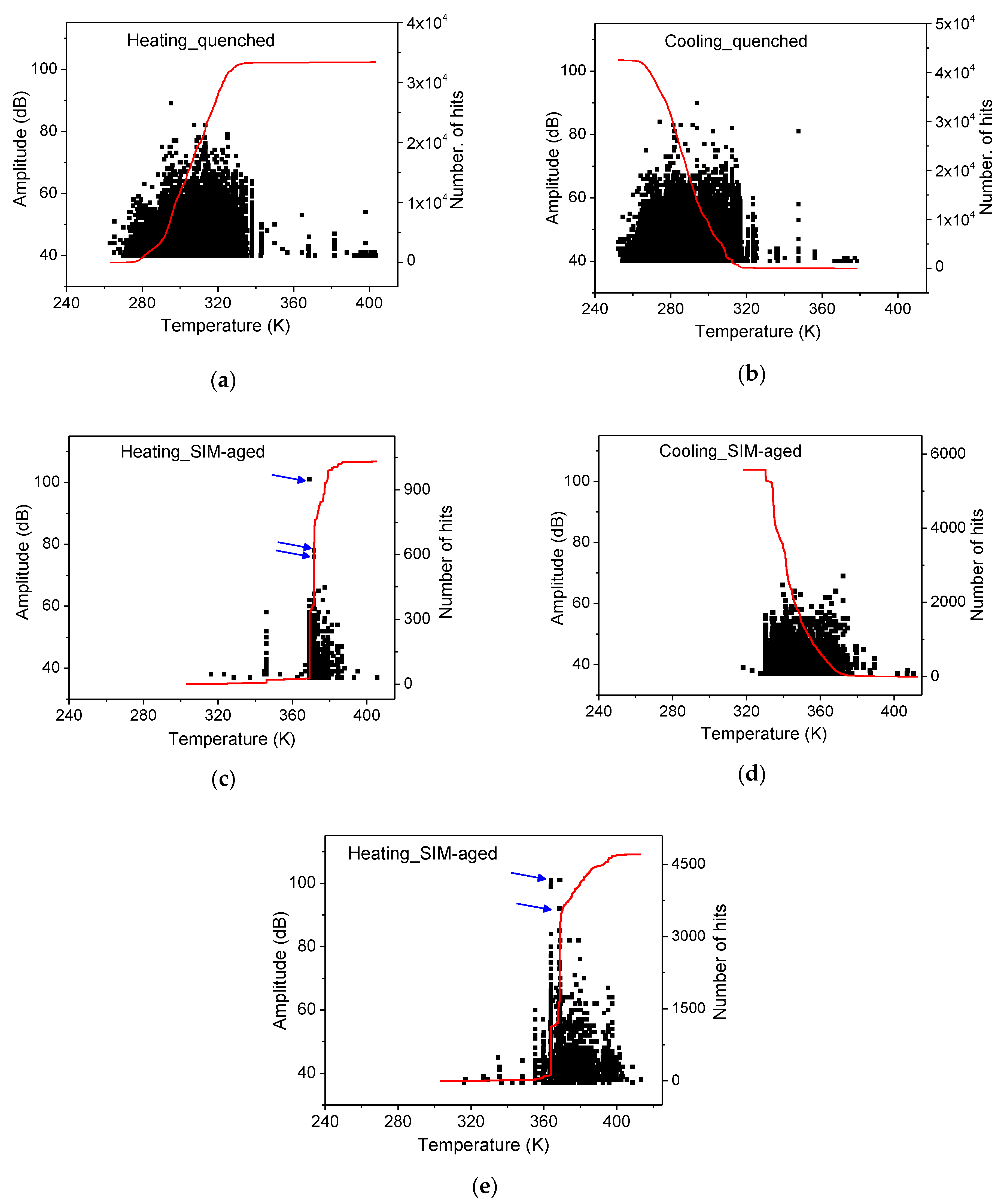
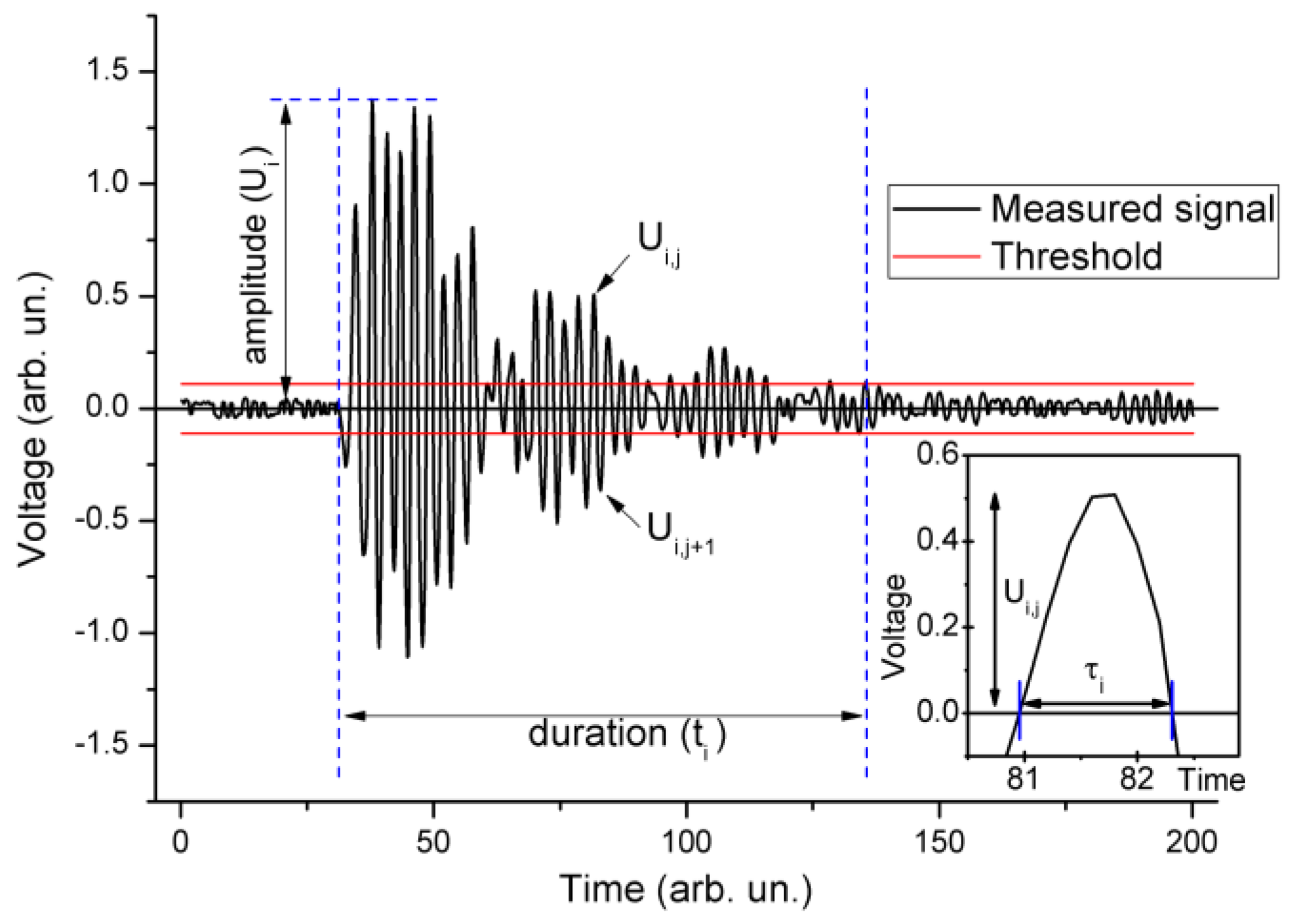



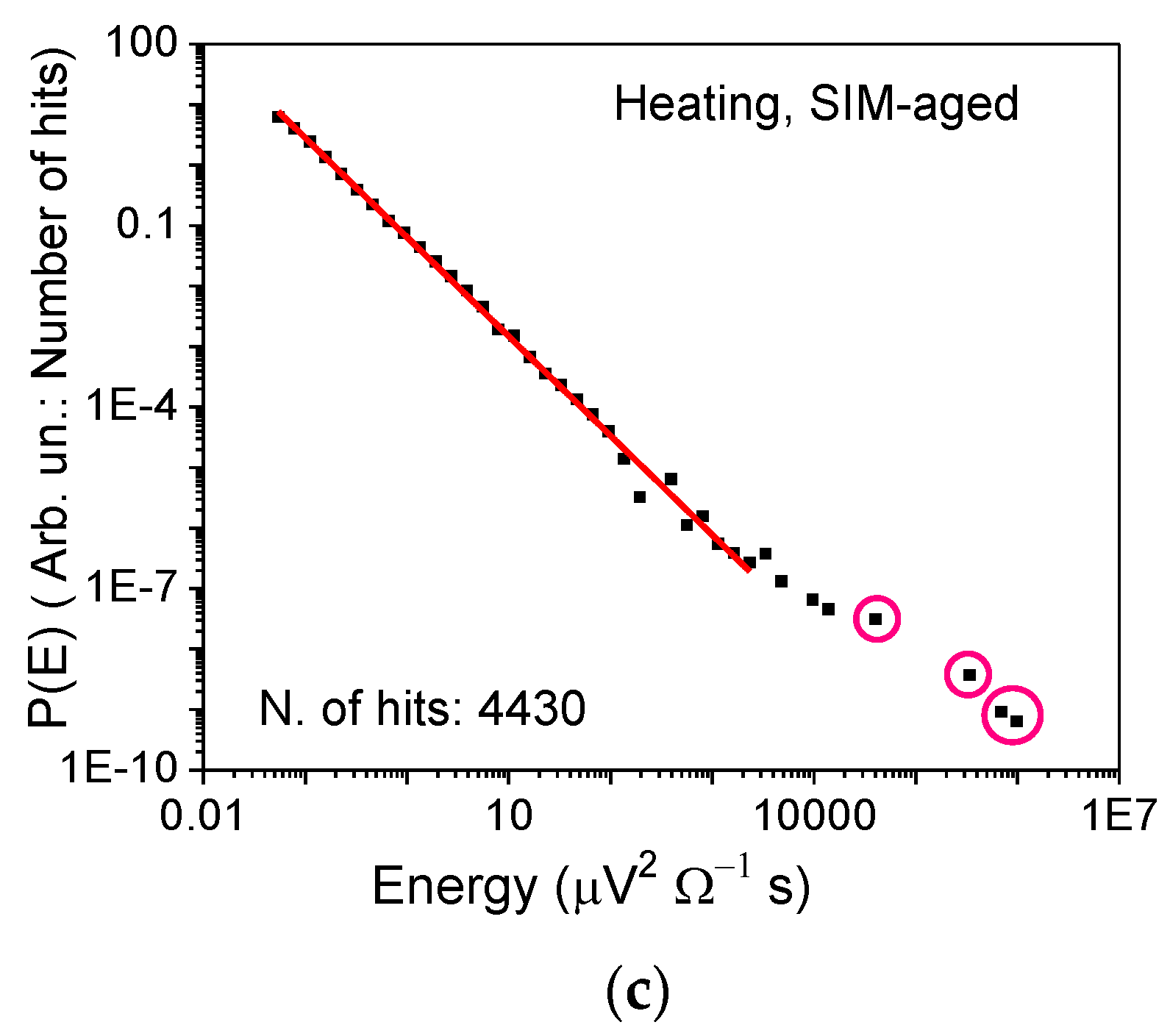
4. Discussion
- There are high amplitude/energy hits during heating and these fall above the points on the energy distribution function.
- Removing these, the energy exponent agrees with the other three values in Table 3 and the average peak energy has similar value to the others.
5. Conclusions
- The energy distributions of acoustic hits in SIM-aged samples showed similar behaviour to those of the quenched sample, and the energy exponents characterizing the power law behaviour were also similar.
- For heating, in accordance with the sharper transition observed in the DSC run, few high amplitude/energy solitary hits were observed, and these points did not fit to the energy distribution function fitted at smaller energies. Thus, these high-energy events were attributed to high sudden jumps in the phase transition during heating. These high, almost vertical jumps, in the cumulative numbers in Figure 4c, agreed well with the temperature of the second DSC peak in Figure 2a. Thus, we attributed the few large energy jumps to jumps of high austenite/martensite interface velocity; this velocity can be orders of magnitude larger than the other velocities with which the interface moves in the quenched sample.
- It was found that the transformation entropy was about 36% smaller for the SIM-aged sample and was practically unchanged after austenite stabilization.
Author Contributions
Funding
Conflicts of Interest
References
- Niendorf, T.; Krooß, P.; Somsen, C.; Eggeler, G.; Chumlyakov, Y.I.; Maier, H.J. Martensite aging - Avenue to new high temperature shape memory alloys. Acta Mater. 2015, 89, 298–304. [Google Scholar] [CrossRef]
- Picornell, C.; Pons, J.; Cesari, E. Stabilisation of martensite by applying compressive stress in Cu-Al-Ni single crystals. Acta Mater. 2001, 49, 4221–4230. [Google Scholar] [CrossRef]
- Chernenko, V.A.; Pons, J.; Cesari, E.; Zasimchuk, I.K. Transformation behaviour and martensite stabilization in the ferromagnetic Co-Ni-Ga Heusler alloy. Scr. Mater. 2004, 50, 225–229. [Google Scholar] [CrossRef]
- Kadletz, P.M.; Krooß, P.; Chumlyakov, Y.I.; Gutmann, M.J.; Schmahl, W.W.; Maier, H.J.; Niendorf, T. Martensite stabilization in shape memory alloys - Experimental evidence for short-range ordering. Mater. Lett. 2015, 159, 16–19. [Google Scholar] [CrossRef]
- Eftifeeva, A.; Panchenko, E.; Chumlyakov, Y.; Maier, H.J. Two-way shape memory effect in [001] B2-oriented Co-Ni-Al single crystals. Mater. Today Proc. 2017, 4, 4789–4796. [Google Scholar] [CrossRef]
- Panchenko, E.Y.; Timofeeva, E.E.; Larchenkova, N.G.; Chumlyakov, Y.I.; Tagiltsev, A.I.; Maier, H.J.; Gerstein, G. Two-way shape memory effect under multi-cycles in [001]-oriented Ni49Fe18Ga27Co6 single crystal. Mater. Sci. Eng. A 2017, 706, 95–103. [Google Scholar] [CrossRef]
- Gerstein, G.; L’vov, V.A.; Kosogor, A.; Maier, H.J. Internal pressure as a key thermodynamic factor to obtain high-temperature superelasticity of shape memory alloys. Mater. Lett. 2018, 210, 252–254. [Google Scholar] [CrossRef]
- Panchenko, E.; Eftifeeva, A.; Chumlyakov, Y.; Gerstein, G.; Maier, H.J. Two-way shape memory effect and thermal cycling stability in Co35Ni35Al30 single crystals by low-temperature martensite ageing. Scr. Mater. 2018, 150, 18–21. [Google Scholar] [CrossRef]
- Timofeeva, E.E.; Panchenko, E.Y.; Pichkaleva, M.V.; Tagiltsev, A.I.; Chumlyakov, Y.I. The effect of stress-induced martensite ageing on the two-way shape memory effect in Ni53Mn25Ga22 single crystals. Mater. Lett. 2018, 228, 490–492. [Google Scholar] [CrossRef]
- Panchenkoa, E.Y.; Timofeeva, E.E.; Chumlyakov, Y.I.; Osipovich, K.S.; Tagiltsev, A.I.; Gerstein, G.; Maier, H.J. Compressive shape memory actuation response of stress-induced martensite aged Ni51Fe18Ga27Co4 single crystals. Mater. Sci. Eng. A 2019, 746, 448–455. [Google Scholar] [CrossRef]
- Panchenko, E.; Timofeeva, E.; Eftifeeva, A.; Osipovich, K.; Surikov, N.; Chumljakov, Y.; Gerstein, G.; Maier, H.J. Giant rubber-like behavior induced by martensite aging in Ni51Fe18Ga27Co4 single crystals. Scr. Mater. 2019, 162, 387–390. [Google Scholar] [CrossRef]
- Ahlers, M.; Pelegrina, J.L. Ageing of martensite: Stabilisation and ferroelasticity in Cu-based shape memory alloys. Mater. Sci. Eng. A 2003, 356, 298–315. [Google Scholar] [CrossRef]
- Ren, X.; Otsuka, K. Origin of rubber-like behaviour in metal alloys. Nature 1997, 389, 579–582. [Google Scholar] [CrossRef]
- Otsuka, K.; Ren, X. Mechanism of martensite aging effects and new aspects. Mater. Sci. Eng. A 2001, 312, 207–218. [Google Scholar] [CrossRef]
- Lauhoff, C.; Krooß, P.; Langenkämper, D.; Somsen, C.; Eggeler, G.; Kireeva, I.; Chumlyakov, Y.I.; Niendorf, T. Martensite aging in 〈001〉 oriented Co49Ni21Ga30 single crystals in tension. Funct. Mater. Lett. 2018, 11, 1850024. [Google Scholar] [CrossRef]
- Segui, C.; Cesari, E. Contributions to the transformation entropy change and influencing factors in metamagnetic Ni-Co-Mn-Ga shape memory alloys. Entropy 2014, 16, 5560–5574. [Google Scholar] [CrossRef]
- Zhao, D.; Xiao, F.; Nie, Z.; Cong, D.; Sun, W.; Liu, J. Burst-like superelasticity and elastocaloric effect in [011] oriented Ni50Fe19Ga27Co4 single crystals. Scr. Mater. 2018, 149, 6–10. [Google Scholar] [CrossRef]
- Nikolaev, V.I.; Yakushev, P.N.; Malygin, G.A.; Averkin, A.I.; Pulnev, S.A.; Zograf, G.P.; Kustov, S.B.; Chumljakov, Y.I. Influence of partial shape memory deformation on the burst character of its recovery in heated Ni–Fe–Ga–Co alloy crystals. Tech. Phys. Lett. 2016, 42, 399–402. [Google Scholar] [CrossRef]
- Kustov, S.; Pons, J.; Cesari, E.; Van Humbeeck, J. Chemical and mechanical stabilization of martensite. Acta Mater. 2004, 52, 4547–4559. [Google Scholar] [CrossRef]
- Beke, D.L.; Daróczi, L.; Tóth, L.Z.; Bolgár, M.K.; Samy, N.M.; Hudák, A. Acoustic emissions during structural changes in shape memory Alloys. Metals 2019, 9, 58. [Google Scholar] [CrossRef]
- Pelegrina, J.L.; Ahlers, M. The martensitic phases and their stability in Cu-Zn and Cu-Zn-Al alloys-I. The transformation between the high temperature β phase and the 18R martensite. Acta Metall. Mater. 1992, 40, 3205–3211. [Google Scholar] [CrossRef]
- Chandrasekaran, M.; Cooreman, L.; Van Humbeeck, J.; Delaey, L. Martensitic transformation in Cu-Zn-Al: changes in transformation entropy due to post quench ageing in the β or martensitic condition. Scr. Metall. 1989, 23, 239–273. [Google Scholar] [CrossRef]
- Imano, Y.; Omori, T.; Oikawa, K.; Sutou, Y.; Kainuma, R.; Ishida, K. Martensitic and magnetic transformations of Ni-Ga-Fe-Co ferromagnetic shape memory alloys. Mater. Sci. Eng. A 2006, 438–440, 970–973. [Google Scholar] [CrossRef]
- Bolgár, M.K.; Tóth, L.Z.; Szabó, S.; Gyöngyösi, S.; Daróczi, L.; Panchenko, E.Y.; Chumlyakov, Y.I.; Beke, D.L. Thermal and acoustic noises generated by austenite/martensite transformation in NiFeGaCo single crystals. J. Alloys Compd. 2016, 658, 29–35. [Google Scholar] [CrossRef]
- Planes, A.; Macqueron, J.L.; Ortîn, J. Energy contributions in the martensitic transformation of shape-memory alloys. Philos. Mag. Lett. 1988, 57, 291–298. [Google Scholar] [CrossRef]
- Beke, D.L.; Daróczi, L.; Elrasasi, T.Y. Determination of elastic and dissipative energy contributions to martensitic phase transformation in shape memory alloys. In Shape Memory Alloys-Processing, Characterization and Applications; Fernandes, F., Ed.; InTech: London, UK, 2013; p. 167. ISBN 978-953-51-1084-2. [Google Scholar]
- Tóth, L.Z.; Daróczi, L.; Szabó, S.; Beke, D.L. Simultaneous investigation of thermal, acoustic, and magnetic emission during martensitic transformation in single-crystalline Ni2MnGa. Phys. Rev. B 2016, 93, 144108. [Google Scholar] [CrossRef]
- Rosinberg, M.L.; Vives, E. Metastability, Hysteresis, Avalanches, and Acoustic Emission: Martensitic Transitions in Functional Materials. In Disorder and Strain Induced Complexity in Functional Materials; Kakeshita, T., Fukuda, T., Saxena, A., Planes, A., Eds.; Springer Series in Materials Science; Springer: Berlin, Germany, 2012; Volume 148, pp. 249–272. ISBN 978-3-642-20943-7. [Google Scholar]
- Planes, A.; Mañosa, L.; Vives, E. Acoustic emission in martensitic transformations. J. Alloys Compd. 2013, 577, S699–S704. [Google Scholar] [CrossRef]
- Bonnot, E.; Vives, E.; Mañosa, L.; Planes, A.; Romero, R. Acoustic emission and energy dissipation during front propagation in a stress-driven martensitic transition. Phys. Rev. B 2008, 78, 094104. [Google Scholar] [CrossRef]
- Mañosa, L.; Planes, A.; Rouby, D.; Morin, M.; Fleischmann, P.; Macqueron, J.L. Acoustic emission field during thermoelastic martensitic transformations. Appl. Phys. Lett. 1989, 54, 2574–2576. [Google Scholar] [CrossRef]
- Gallardo, M.C.; Manchado, J.; Romero, F.J.; Del Cerro, J.; Salje, E.H.; Planes, A.; Vives, E.; Ricardo, R.; Marcelo, S. Avalanche criticality in the martensitic transition of Cu67.64 Zn16.71 Al15.65 shape-memory alloy: A calorimetric and acoustic emission study. Phys. Rev. B 2010, 81, 174102. [Google Scholar] [CrossRef]
- Beke, D.L.; Bolgár, M.K.; Tóth, L.Z.; Daróczi, L. On the asymmetry of the forward and reverse martensitic transformations in shape memory alloys. J. Alloys Compd. 2018, 741, 106–115. [Google Scholar] [CrossRef]
- Marcos, J.; Planes, A.; Manosa, L.; Casanova, F.; Battle, X.; Labarta, A.; Martinez, B. Magnetic field induced entropy change and magnetoelasticity in Ni-Mn-Ga alloys. Phys. Rev. B 2002, 66, 224413. [Google Scholar] [CrossRef]
- Scruby, C.B. Quantitative acoustic emission techniques. In Research Techniques in Non-Destructive Testing; Sharpe, R.S., Ed.; Academic Press: London, UK, 1985; Volume III, ISBN 0126390533. [Google Scholar]
- Zreihan, N.; Faran, E.; Vives, E.; Planes, A.; Shilo, D. Relations between stress drops and acoustic emission measured during mechanical loading. Phys. Rev. Mater. 2019, 3, 043603. [Google Scholar] [CrossRef]
- Santamarta, R.; Cesari, E.; Font, J.; Muntasell, J.; Pons, J.; Dutkiewicz, J. Effect of atomic order on the martensitic transformation of Ni-Fe-Ga alloys. Scr. Mater. 2006, 54, 1985–1989. [Google Scholar] [CrossRef]
- Khovailo, V.V.; Oikawa, K.; Abe, T.; Takagi, T. Entropy change at the martensitic transformation in ferromagnetic shape memory alloys Ni2+xMn1-xGa. J. Appl. Phys. 2003, 93, 8483–8485. [Google Scholar] [CrossRef]
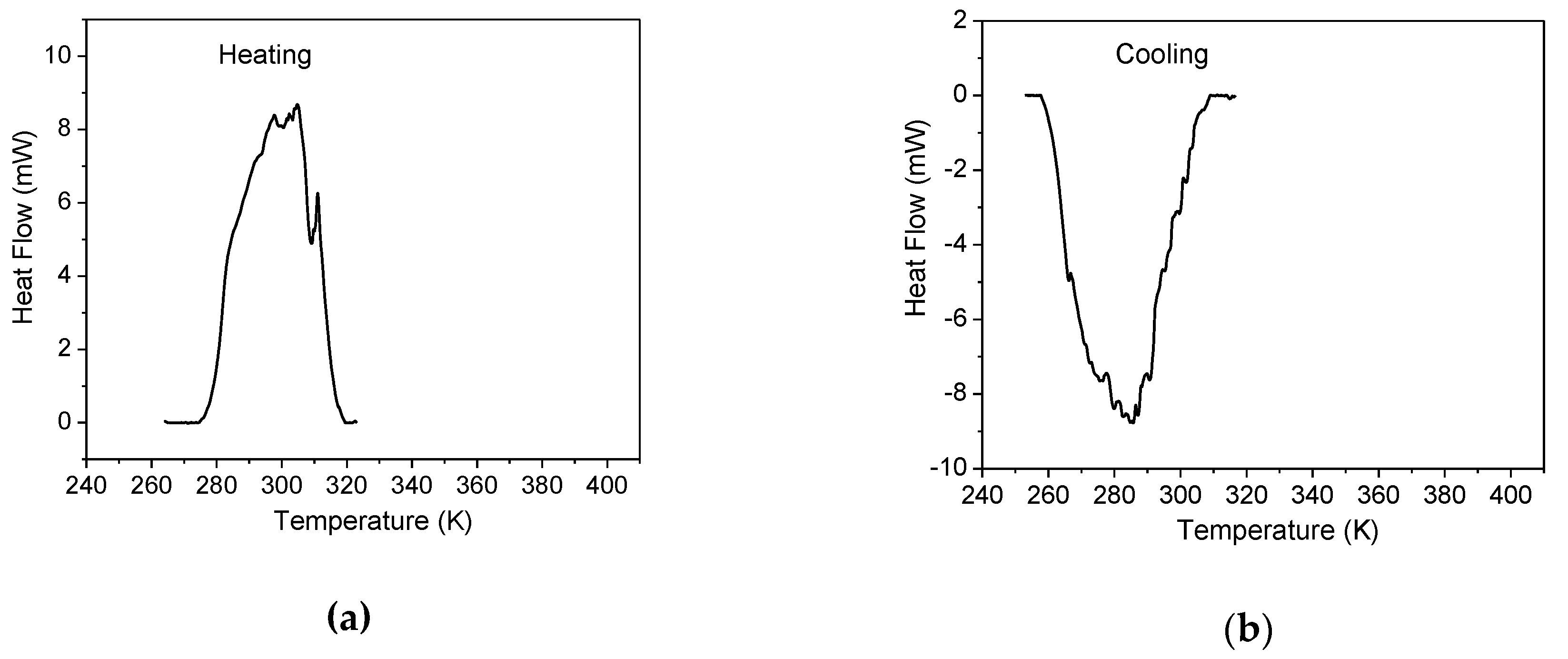
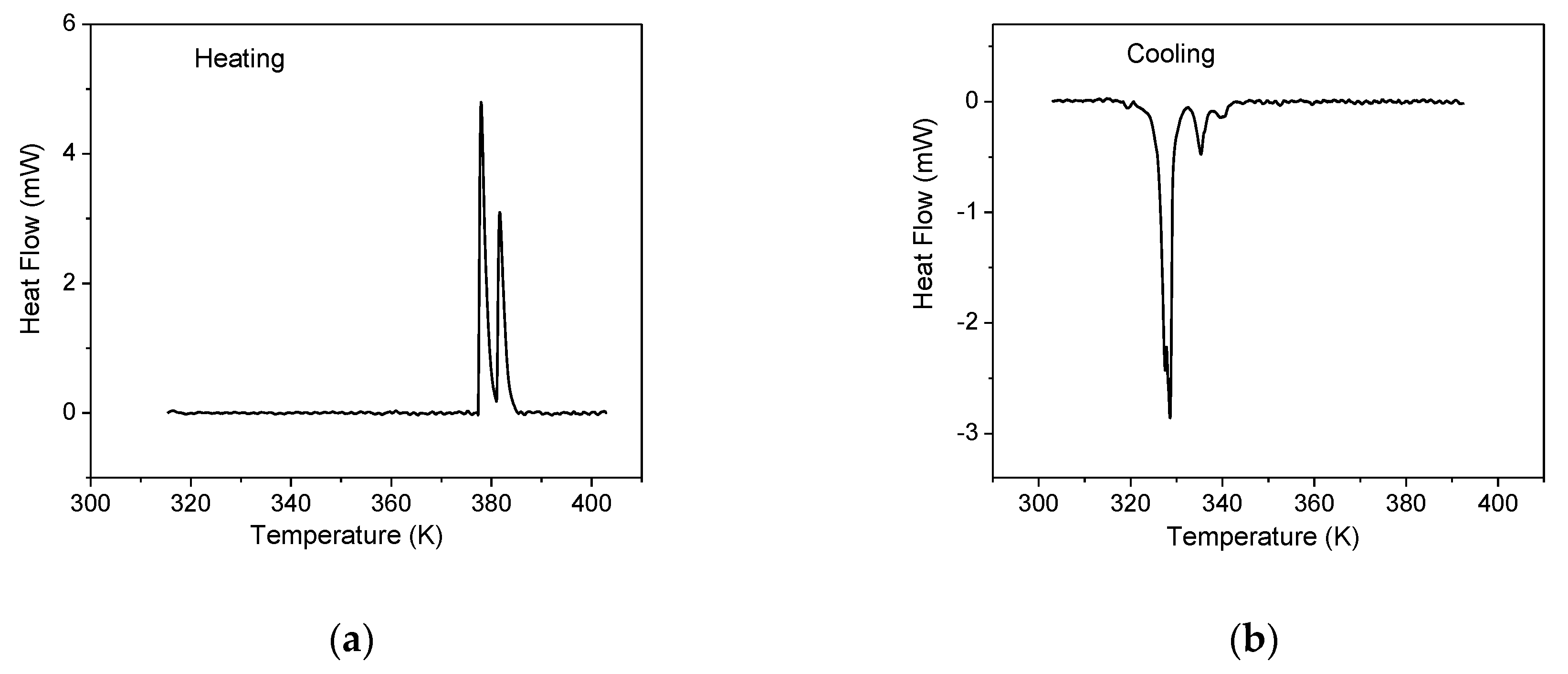
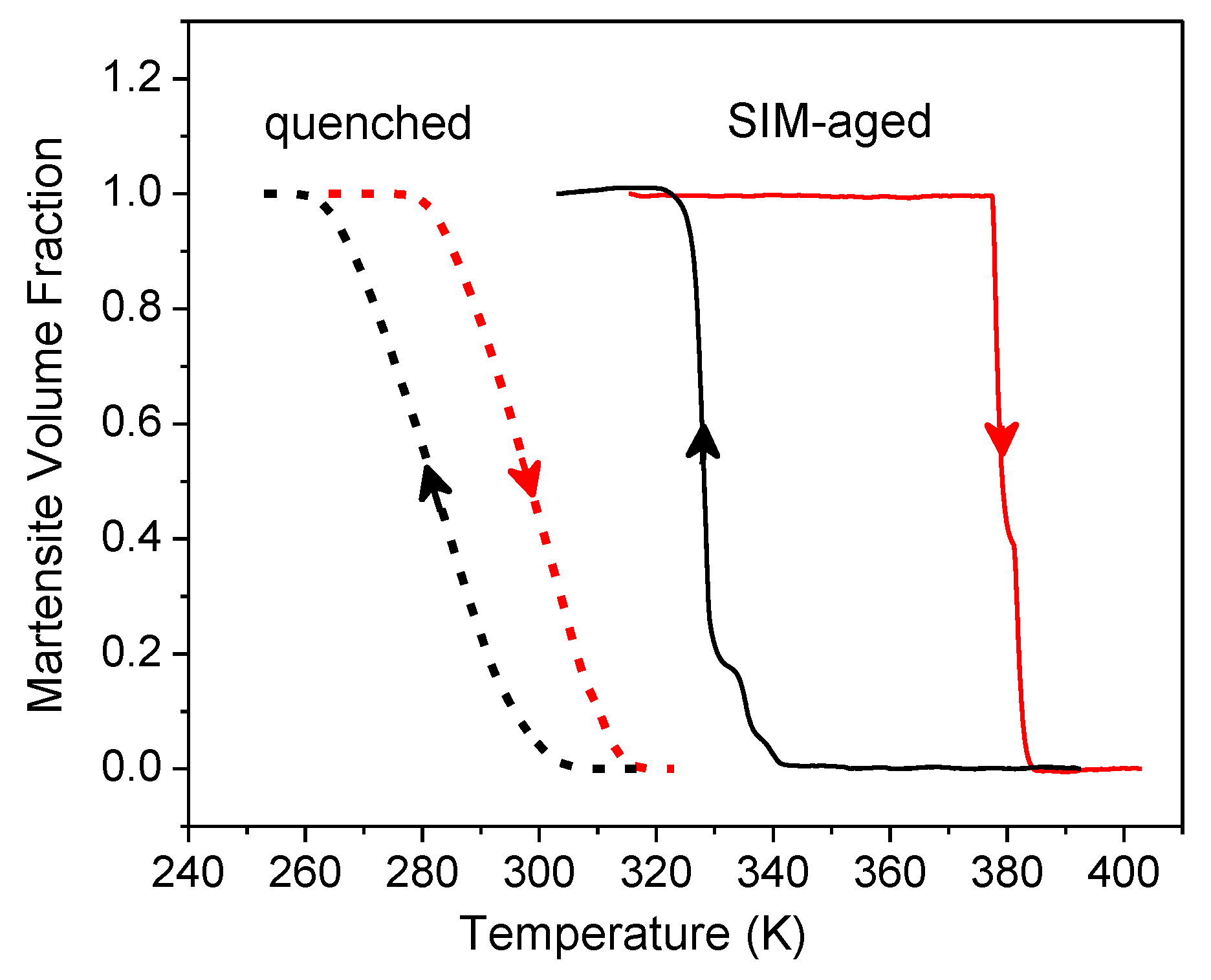


| Type of Sample | AS | Af | Ms | Mf |
|---|---|---|---|---|
| Quenched, AE | 270 | 337 | 317 | 254 |
| Quenched, DSC | 276 | 320 | 308 | 259 |
| Austenite Stabilized, AE | 270 | 337 | 317 | 254 |
| SIM-aged, DSC | 377 | 386 | 343 | 317 |
| −ΔS | Quenched | Austenite Stabilized | SIM-Aged |
|---|---|---|---|
| (J/mol∙K) | 0.94 | 0.94 | 0.60 |
| Type of Sample | AE for Heating | AE for Cooling | ||||||
|---|---|---|---|---|---|---|---|---|
| N | Et | Eav | ε | N | Et | Eav | ε | |
| Quenched | 32077 | 6.1 × 104 | 1.9 | 1.84 ± 0.06 | 40500 | 1.4 × 105 | 3.6 | 1.87 ± 0.06 |
| Austenite Stabilized | 18891 | 9.2 × 103 | 0.5 | 1.97 ± 0.06 | 26930 | 4.0 × 104 | 1.5 | 1.94 ± 0.12 |
| SIM-aged | 967 | 1.9 × 106 | 1970 | - | 5278 | 1062 | 0.2 | 1.2 ± 0.1 |
| SIM-aged, removing high energy events | 964 | 769 | 0.8 | 1.7 ± 0.3 | - | - | - | - |
© 2020 by the authors. Licensee MDPI, Basel, Switzerland. This article is an open access article distributed under the terms and conditions of the Creative Commons Attribution (CC BY) license (http://creativecommons.org/licenses/by/4.0/).
Share and Cite
Samy, N.M.; Daróczi, L.; Tóth, L.Z.; Panchenko, E.; Chumlyakov, Y.; Surikov, N.; Beke, D.L. Effect of Stress-Induced Martensite Stabilization on Acoustic Emission Characteristics and the Entropy of Martensitic Transformation in Shape Memory Ni51Fe18Ga27Co4 Single Crystal. Metals 2020, 10, 534. https://doi.org/10.3390/met10040534
Samy NM, Daróczi L, Tóth LZ, Panchenko E, Chumlyakov Y, Surikov N, Beke DL. Effect of Stress-Induced Martensite Stabilization on Acoustic Emission Characteristics and the Entropy of Martensitic Transformation in Shape Memory Ni51Fe18Ga27Co4 Single Crystal. Metals. 2020; 10(4):534. https://doi.org/10.3390/met10040534
Chicago/Turabian StyleSamy, Nora Mohareb, Lajos Daróczi, László Zoltán Tóth, Elena Panchenko, Yury Chumlyakov, Nikita Surikov, and Dezső László Beke. 2020. "Effect of Stress-Induced Martensite Stabilization on Acoustic Emission Characteristics and the Entropy of Martensitic Transformation in Shape Memory Ni51Fe18Ga27Co4 Single Crystal" Metals 10, no. 4: 534. https://doi.org/10.3390/met10040534
APA StyleSamy, N. M., Daróczi, L., Tóth, L. Z., Panchenko, E., Chumlyakov, Y., Surikov, N., & Beke, D. L. (2020). Effect of Stress-Induced Martensite Stabilization on Acoustic Emission Characteristics and the Entropy of Martensitic Transformation in Shape Memory Ni51Fe18Ga27Co4 Single Crystal. Metals, 10(4), 534. https://doi.org/10.3390/met10040534







